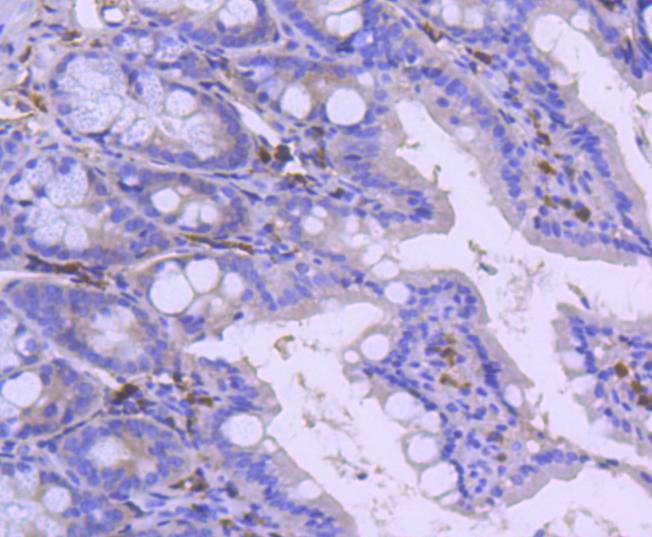PARP1 Recombinant Rabbit Monoclonal Antibody [SU03-68], Unconjugated
- Bilder (5)
| Artikelname: | PARP1 Recombinant Rabbit Monoclonal Antibody [SU03-68], Unconjugated |
| Artikelnummer: | HBO-ET1608-56 |
| Hersteller Artikelnummer: | ET1608-56 |
| Alternativnummer: | HBO-ET1608-56 |
| Hersteller: | HUABIO |
| Wirt: | Rabbit |
| Kategorie: | Antikörper |
| Applikation: | FC, IF, IHC-P, WB |
| Spezies Reaktivität: | Human, Mouse, Rat |
| Immunogen: | Synthetic peptide within N-terminal human PARP1. |
| Konjugation: | Unconjugated |
| Alternative Synonym: | ADP ribosyltransferase (NAD+, poly (ADP ribose) polymerase) antibody ADP ribosyltransferase diphtheria toxin like 1 antibody ADP ribosyltransferase NAD(+) antibody ADPRT 1 antibody ADPRT antibody ADPRT1 antibody ARTD1 antibody msPARP antibody NAD(+) ADP |
| The main role of PARP (found in the cell nucleus) is to detect and initiate an immediate cellular response to metabolic, chemical, or radiation-induced single-strand DNA breaks (SSB) by signaling the enzymatic machinery involved in the SSB repair. Once P |
TARGETUNIPROT #P09874 PROTEIN NAME PARP SYNONYMS ADP ribosyltransferase (NAD+; poly (ADP ribose) polymerase) antibody; ADP ribosyltransferase diphtheria toxin like 1 antibody; ADP ribosyltransferase NAD(+) antibody; ADPRT 1 antibody; ADPRT antibody; ADPRT1 antibody; ARTD1 antibody; msPARP antibody; NAD(+) ADP ribosyltransferase 1 antibody; NAD(+) ADP-ribosyltransferase 1 antibody; pADPRT 1 antibody; pADPRT1 antibody; PARP 1 antibody; PARP antibody; PARP-1 antibody; PARP1 antibody; PARP1_HUMAN antibody; Poly (ADP ribose) polymerase 1 antibody; poly (ADP ribose) polymerase family, member 1 antibody; Poly [ADP-ribose] polymerase 1 antibody; Poly(ADP ribose) polymerase antibody; poly(ADP ribose) synthetase antibody; poly(ADP ribosyl)transferase antibody; Poly[ADP ribose] synthetase 1 antibody; Poly[ADP-ribose] synthase 1 antibody; PPOL antibody POST-TRANSLATIONAL MODIFICATION Phosphorylated by PRKDC and TXK.; Poly-ADP-ribosylated on glutamate and aspartate residues by autocatalysis. Poly-ADP-ribosylated by PARP2; poly-ADP-ribosylation mediates the recruitment of CHD1L to DNA damage sites. ADP-ribosylated on serine by autocatalysis; serine ADP-ribosylation takes place following interaction with HPF1.; S-nitrosylated, leading to inhibit transcription regulation activity. SUBCELLULAR LOCATION Nucleus. FUNCTION PARP, a 116 kDa nuclear poly (ADP-ribose) polymerase, appears to be involved in DNA repair in response to environmental stress. This protein can be cleaved by many ICE-like caspases in vitro and is one of the main cleavage targets of caspase-3 in vivo. In human PARP, the cleavage occurs between Asp214 and Gly215, which separates the PARP amino-terminal DNA binding domain (24 kDa) from the carboxy-terminal catalytic domain (89 kDa). PARP helps cells to maintain their viability; cleavage of PARP facilitates cellular disassembly and serves as a marker of cells undergoing apoptosis. |
| Klonalität: | Monoclonal |
| Konzentration: | 1 mg/mL. |
| Klon-Bezeichnung: | [SU03-68] |
| Molekulargewicht: | Predicted band size: 113 kDa |
| Isotyp: | IgG |
| UniProt: | P09874 |
| Puffer: | 1*TBS (pH7.4), 0.05% BSA, 40% Glycerol. Preservative: 0.05% Sodium Azide. |
| Reinheit: | Protein A affinity purified. |
| Formulierung: | Liquid |
| Target-Kategorie: | PARP-1, ARTD1, ADPRT 1, PARP1 |
| Antibody Type: | Primary Antibody |
| Application Verdünnung: | WB: 1:2,000 ,IF-Cell: 1:500 ,IF-Tissue: 1:50-1:800 ,IHC-P: 1:500-1:4,000 ,FC: 1:1,000 |



